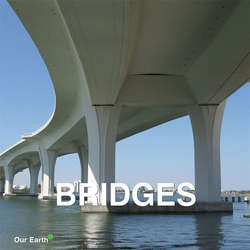Читать книгу Bridges - Victoria Charles - Страница 3
На сайте Литреса книга снята с продажи.
Introduction
ОглавлениеThe urban and rural landscapes of today are marked with many structures that are frequently overlooked because of their habitual use. Bridges are examples of such structures. Do residents of San Francisco often fall into raptures over the remarkable Golden Gate Bridge, Parisians over the Pont Alexandre III or Londoners over the Tower Bridge? In fact, bridges’ aesthetic qualities and often the impressive technological prowess that contributed to their creation deserve an admiring pause: bridges are in essence dynamic sculptures, inhabiting the landscape, marking society’s development throughout history. These structures made of wood, stone or iron represent the means of physical communication, from railroads to interstate highways, that connect our villages, our cities, our provinces, our countries. Soaring over streams and rivers, overcoming ravines and linking continents, bridges are essential to civilisation and unifying tools for society. These masterpieces of architecture rise above mere utility and become the simultaneous expressions of our history and our future.
Was the first bridge perhaps an accident of nature? Most likely a fallen tree landed across the banks of a river, connecting the opposite sides. Before man learned of the advantage of crossing bodies of water without getting wet, animals undoubtedly borrowed this new route. Imitating this original natural bridge, so rudimentary at first glance, man discovered that it was possible to make the passages more sophisticated, endowing bridges with strength and durability.
As civilisations developed and progressed, bridges were constructed with finely-worked wood and stones were used to reinforce their foundations. Earlier than the third millennium B. C. E., frescoes and texts refer to the construction of bridges in association with the names of monarchs, who used the structures as demonstrations of their power and endurance. Two bridges have found permanent places in history: that of Egyptian pharaoh Menes, constructed around 2560 B. C. E. across the Nile, and that of Assyrian Queen Semiramis, built over the River Euphrates several centuries later.
With the barbarian invasions of the 5th and 6th centuries C. E., Roman lines were pushed back by marauding groups from the East. Visigoths, Franks, Huns and Vandals surged through the civilised world, leaving ruined cities, roads and bridges in the wake of their violence.
Stability was restored to Europe in the 7th century. In the late 8th century, Charlemagne reassembled lands into a unified territory and, feeling the need for rapid movement of troops, began to improve the paths of communication in the heart of Europe. The renovation efforts, while modest, were put into effect, and soon various construction methods were discovered or rediscovered.
The Middle Ages saw marked progress under pressure from merchants who were developing their business enterprises beyond the limits of their hometowns. Bridges were once again in demand, old remnants restored and new bridges appearing at strategic locations over streams and rivers.
During the Renaissance, bridges became indispensable to commerce and warring armies throughout Europe. Adding to their utilitarian qualities, bridges were endowed with importance by princes, who wished to impress their contemporaries and demonstrate their prestige by leaving lasting monuments like bridges in their respective cities. Bridges were erected thus in Florence, Venice, Paris and London, often housing shops or residences. The development of tolls as a way of taxing goods or people crossing the waterways further increased the popularity of bridges during the Renaissance. Thanks to the cultural rebirth and scientific innovations of this period, people were able to build longer, more artistically complex bridges. In 1747, under the supervision of Louis XV, France became the first country to establish a specialised school for urban engineering: the École Royale des Ponts et Chaussées.
Throughout the 18th and 19th centuries, construction techniques advanced at an incredible pace with new discoveries. Wood and stone, which had remained the materials of choice for bridge-building, were being replaced by the stronger, more practical substances bronze, iron and steel. Engineers, no longer timid or restrained by technological limitations, spanned every stream and river in the western world with a bridge, permitting, at the same time, the development of railroads.
As countries, cities and towns were thus connected by new means of communication and as trains became heavier and longer, further innovations in the construction of bridges became necessary. In addition to improving the technical properties of these passageways, engineers like Gustave Eiffel, with his Garabis viaduct, built in 1882, used metal and its capabilities to raise the aesthetic value of bridges to the level of architectural monuments, testifying to the triumphant 19th century. Furthermore, with Europe’s colonisation of Asia and Africa, the entire world was being transformed into wide streets, bridges and other ingenious roadways.
The 20th century was the century of the automobile, large roads and highways, continuing to serve millions of people. The bridges built in modern times are taller, wider and constantly more numerous; nothing seems to stand in the way of engineers, no ravine, stream or river is too deep or wide or wild to be spanned.
However, even in the midst of this frenetic industrial pace, many bridges created in the past have today become symbols rather than structures, like the ‘bridge on the River Kwai’, immortal testimonials to our collective history.
Bogdan Khmelnitsky (Kievsky) Pedestrian Bridge
Location: Moscow, Russia. Crosses: Moskva River
Material and type: Arch bridge, two hinged
Completed: 2 September 2001
Alcántara Bridge
Location: Alcántara, Extremadura, Spain
Crosses: Tagus River. Architect: Gaius Julius Lacer
Material and type: Arch bridge, opus quadratum (stone)
Dimensions: length: 194 m, width: 8 m, height: 71 m, arches: 6
Construction: c. 104–106 C. E.
